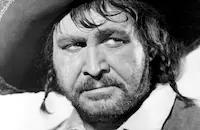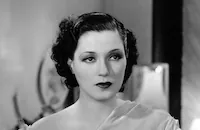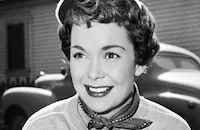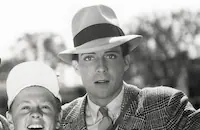Smart Blonde

Brief Synopsis
Cast & Crew
Frank Mcdonald
Glenda Farrell
Barton Maclane
Winifred Shaw
Addison Richards
David Carlyle
Film Details
Technical Specs

Synopsis
After nightclub owner Fitz Mularkay sells his business enterprises because he intends to marry Marcia Friel, who disapproves of them, Torchy Blane, a reporter, interviews Tiny Torgensen, the man who bought the business and who is a close friend of Fitz. As they leave Union Station, Torgensen is shot. Torchy's boyfriend, police sergeant Steve McBride, who is in charge of the case, brings Torchy with him to Fitz's nightclub. While he investigates, Torchy learns from the hat check girl, Dixie, that singer Dolly Ireland was in love with Fitz and that Fitz's right-hand man, Chuck, was angry about losing his job. Steve suspects the other bidders for the business, but Torchy suspects Chuck. She persuades Steve to look for him, and while they are at Chuck's apartment, Fitz shows up and demands to know what the police have on his man. Steve learns that Chuck and Dolly were seen at Union Station just before Torgensen was killed. Meanwhile, Torchy lunches with Fitz's fiancée Marcia, who begs her to convince Fitz to sell his business to anyone who wants to buy it. When Chuck is found murdered, Steve immediately suspects Fitz, but later decides that he is covering for someone and he accuses Dolly. When the forensics report states that Chuck's gun did not kill Torgensen, Marcia tells Steve that because Chuck threatened her, she is afraid that Fitz killed him to protect her. Torchy becomes suspicious when Marcia and her brother Louie tell conflicting stories about their parents. Finally, Torchy deduces that Louis and Marcia are crooks who have been trying to take Fitz for his money and that Louie killed Torgensen when he recognized Marcia as an imposter. Fitz decides to stay in business and proposes to Dolly, his real love. Inspired, Steve proposes to Torchy.

Director
Frank Mcdonald
Cast

Glenda Farrell

Barton Maclane

Winifred Shaw

Addison Richards

David Carlyle

Craig Reynolds
Charlotte Winters

Jane Wyman

Joseph Crehan

Tom Kennedy
John Sheehan
Max Wagner
George Lloyd
Cliff Saum

Paul Panzer
Al Hill
Allen Pomeroy
Joseph Cunningham
Jack H. Richardson
Robert E. Homans

Jack Mower
Chic Bruno
Al Herman
Lyle Moraine
Jack Wise
Ferdinand Schumann-heink

George Andre Beranger
Saul Gorss
George Guhl
Glen Cavender
Harry Jacobson
Carlyle Moore Jr.
Eddy Chandler
Alexander Cross
Harry Fox
Frank Faylen

Dennis Moore
Stuart Holmes

Tom Wilson

Wayne Morris
Martin Turner
Fred "snowflake" Toones
Milton Kibbee
Crew
Milo Anderson
Harold Buckley
Bryan Foy
Kenneth Gamet
William Jacobs
M. K. Jerome
Ben Grauman Kohn
Warren Lynch
Frank Magee
Wilbur Mcgaugh
Don Ryan
Jack Scholl
Harry Seymour
Barry Starr
Jack L. Warner
Carl Jules Weyl

Film Details
Technical Specs

Articles
Smart Blonde
The Staten Island-born Nebel had quit high school at age 15 and came of age laboring as a longshoreman and deckhand aboard a tramp steamer. Visiting family in Canada, he turned his hand to farming and began to write adventure tales and westerns that later saw publication in Action Stories, North West Stories, and Lariat. Nebel sold his first crime tale to Black Mask in 1926 and went on to become the pulp magazine's second best writer, after Dashiell Hammett. Between 1928 and 1937, Nebel (who succeeded Hammett as Black Mask's top writer after the creator of Sam Spade and The Continental Op was wooed west by Hollywood) wrote thirty-seven novelettes detailing the exploits of incorruptible Richmond City police captain Steve MacBride and his dipsomaniacal journalist pal Kennedy (no first name) of The Free Press. Warner Brothers paid out for the MacBride and Kennedy stories but jettisoned the problematic Kennedy (whose alcoholism would have drawn fire from the Production Code) in favor of a female partner - and love interest - for MacBride. Having just played a show girl in Gold Diggers of 1937 (1936), Farrell slotted easily into the more sensible shoes of Torchy Blane, a former hoofer turned newshound and amateur sleuth.
Based on Frederick Nebel's 1936 story "No Hard Feelings" (one of the last in the Black Mask series), Smart Blonde rolled into production in the fall of 1936, retaining Nebel's title and with former dialogue director Frank McDonald at the helm. Cast as the authoritative yang to Farrell's irreverent yin was movie tough guy Barton MacLane, a reliable Hollywood heavy whose lawbreakers evinced a distinctive cruel streak - plugging gun moll Ann Dvorak in the back in William Keighley's "G" Men (1935) and sending an innocent Boris Karloff to the electric chair in Michael Curtiz's The Walking Dead (1936); even when playing a prison guard in Lloyd Bacon's San Quentin (1937), MacLane was an irredeemable shit. The bulldog-like MacLane was an out-of-left-field choice to play Lt. Steve McBride (note the alteration of his surname and demotion in rank) and it remains remarkable in retrospect how little he had to vary his gangster shtick to play a good guy (and not, it bears mentioning, for the first time). Vastly different in temperament from MGM's Nick and Nora Charles or Warners' own Perry Mason and Nancy Drew, Torchy and Steve were rough-hewn, working class, beer-and-pretzels types more at home in a chop house than a nightclub.
Public reaction to "the Lady Bloodhound with the Nose for News" was sufficiently favorable for Warners to greenlight a follow-up, Fly Away Baby (1937), released only six months after Smart Blonde's January 1937 premiere. In all, there would be nine Torchy tales before the series wrapped in 1939. Farrell and MacLane appeared in seven of the nine, replaced by Lola Lane and Paul Kelly in Torchy Blane in Panama (1938) and Jane Wyman (who had popped up in Smart Blonde in a bit as a hatcheck girl) and Allen Jenkins in Torchy Blane... Playing with Dynamite (1939). The only principal player to remain constant throughout the series was Tom Kennedy, who recurred as McBride's childlike driver Gahagan. In a letter to Time magazine in 1988, Superman co-creator Jerry Siegel admitted that he and partner Joe Shuster had based Clark Kent's Daily Planet colleague and love interest Lois Lane (who made her Action Comics debut in June 1938) on the indefatigable Torchy, with Glenda Farrell the physical model and the character's surname cadged from Torchy Blane in Panama star Lola Lane.
By Richard Harland Smith
Sources:
"Frederick Nebels' Hardboiled Heroes" by Walker Martin, Blood 'n' Thunder, Volume 34 (CreateSpace Independent Publishing Platform, Summer 2012)
Mystery Movie Series of 1930s Hollywood by Ron Backer (McFarland and Company, Ltd., 2012)
Superman Masterpiece Edition: The Golden Age of America's First Super Hero by Les Daniels (Chronicle Books, 1999)

Smart Blonde
Quotes
Trivia
Notes
The film's working title was No Hard Feelings. This was the first film in the Torchy Blane series. Glenda Farrell and Barton MacLane were teamed as "Torchy" and "Steve" in seven of the nine films in the series, which ran until 1939. Lola Lane and Paul Kelly played the roles in the 1938 film Torchy Blane in Panama and Jane Wyman and Allen Jenkins took over the roles in the last film in the series, Torchy Plays with Dynamite. Tom Kennedy, who portrayed "Gahagan," was the only cast member to appear in all nine films. For additional information on the series, consult the Series Index.
















